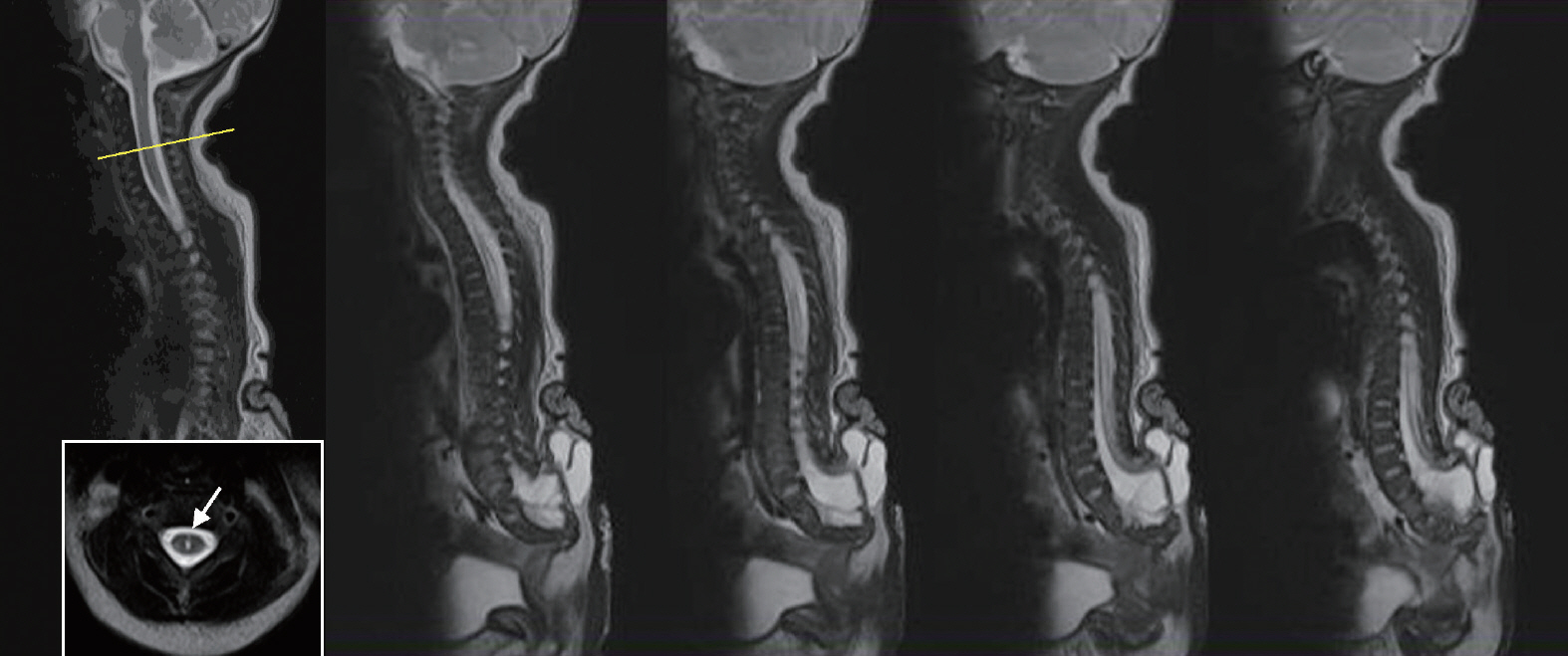J Korean Neurosurg Soc.
2020 May;63(3):338-341. 10.3340/jkns.2020.0097.
Syringomyelia in the Tethered Spinal Cords
- Affiliations
-
- 1Division of Pediatric Neurosurgery, Seoul National University Children’s Hospital, Seoul, Korea
- 2Department of Anatomy and Cell Biology, Seoul National University College of Medicine, Seoul, Korea
- KMID: 2501720
- DOI: http://doi.org/10.3340/jkns.2020.0097
Abstract
- Cases of syringomyelia associated with spinal dysraphism are distinct from those associated with hindbrain herniation or arachnoiditis in terms of the suspected pathogenetic mechanism. The symptoms of terminal syringomyelia are difficult to differentiate from the symptoms caused by spinal dysraphism. Nonetheless, syringomyelia has important clinical implications, as it is an important sign of cord tethering. The postoperative assessment of syringomyelia should be performed with caution.
Keyword
Figure
Reference
-
References
1. Beaumont A, Muszynski CA, Kaufman BA. Clinical significance of terminal syringomyelia in association with pediatric tethered cord syndrome. Pediatr Neurosurg. 43:216–221. 2007.
Article2. Bowman RM, McLone DG, Grant JA, Tomita T, Ito JA. Spina bifida outcome: a 25-year prospective. Pediatr Neurosurg. 34:114–120. 2001.
Article3. Bruzek AK, Starr J, Garton HJL, Muraszko KM, Maher CO, Strahle JM. Syringomyelia in children with closed spinal dysraphism: long-term outcomes after surgical intervention. J Neurosurg Pediatr. 25:209–300. 2020.
Article4. Caldarelli M, Di Rocco C, La Marca F. Treatment of hydromyelia in spina bifida. Surg Neurol. 50:411–420. 1998.
Article5. Erkan K, Unal F, Kiris T, Karalar T. Treatment of terminal syringomyelia in association with tethered cord syndrome: clinical outcomes with and without syrinx drainage. Neurosurg Focus. 8:E9. 2000.
Article6. Greitz D. Unraveling the riddle of syringomyelia. Neurosurg Rev. 29:251–263. discussion 264. 2006.
Article7. Iskandar BJ, Oakes WJ, McLaughlin C, Osumi AK, Tien RD. Terminal syringohydromyelia and occult spinal dysraphism. J Neurosurg. 81:513–519. 1994.
Article8. Kashlan ON, Wilkinson DA, Morgenstern H, Khalsa SS, Maher CO. Predictors of surgical treatment in children with tethered fibrofatty filum terminale. J Neurosurg Pediatr. 25:97–208. 2020.
Article9. Kim KH, Lee JY, Cheon JE, Kim IO, Wang KC. A suggestion to the article “Whole spine MRI is not required in investigating uncomplicated paediatric lumbosacral lipoma: a retrospective single-institution review”: extended lumbosacral spine MRI. Childs Nerv Syst. 36:7–8. 2020.
Article10. Layard Horsfall H, Chari A, Huttunen T, Simcock C, D’Arco F, Thompson D. Whole spine MRI is not required in investigating uncomplicated paediatric lumbosacral lipoma. A retrospective single-institution review. Childs Nerv Syst. 35:2163–2169. 2019.
Article11. Lee JY, Kim SW, Kim SP, Kim H, Cheon JE, Kim SK, et al. A rat model of chronic syringomyelia induced by epidural compression of the lumbar spinal cord. J Neurosurg Spine. 27:458–467. 2017.
Article12. Lee JY, Phi JH, Cheon JE, Kim SK, Kim IO, Cho BK, et al. Preuntethering and postuntethering courses of syringomyelia associated with tethered spinal cord. Neurosurgery. 71:23–29. 2012.
Article13. Tsitouras V, Sgouros S. Syringomyelia and tethered cord in children. Childs Nerv Syst. 29:1625–1634. 2013.
Article
- Full Text Links
- Actions
-
Cited
- CITED
-
- Close
- Share
- Similar articles
-
- Diastematomyelia: A Surgical Case with Long-Term Follow-Up
- Intramedullary Spinal Hemangioblastoma Associated with Syringomyelia
- Syringomyelia Associated with a Spinal Arachnoid Cyst
- Nerve injury in an undiagnosed adult tethered cord syndrome patients following spinal anesthesia: A case report
- Posttraumatic syringomyelia in spinal cord injury: case report



